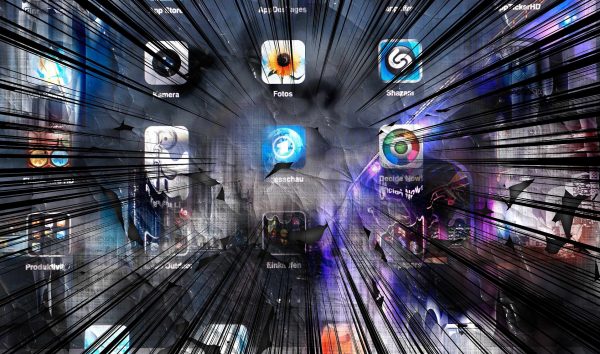Augmented Reality (AR): Alles was Sie im Jahr 2018 wissen müssen.
Pokemon Go. The dancing Hot Dog. Google Glass. Rote Markierungen in Fussballspielen, die Abseitsstellungen leichter erkennbar machen. Dies sind alles Beispiele für AR.
AR ist nicht neu. So verwenden wir beispielsweise die Gesichtsvergrößerungen in Snapchat schon seit Jahren. Aber bis zum Jahr 2017 agierten die Ingenieure und Designer, die AR-Erlebnisse entwickeln, hinter einem geschlossenen Vorhang. Im letzten Jahr warfen die Tech-Giganten der Welt – Facebook, Apple, Google, Amazon und jetzt Snapchat – den Vorhang dramatisch zur Seite und verkündeten, dass fast jeder ein AR-Erlebnis schaffen kann.
Hier ist der Kompromiss: Was wir an Entwicklerfreundlichkeit (native SDKs, Integration in bestehende Workflows) und Leistungssteigerungen (Ladezeiten, Akkueffizienz, Renderqualität, Integration mit nativen Apps) gewinnen, verlieren wir an Universalität – natürlich möchte jedes Unternehmen in seinem eigenen Ökosystem bleiben.
Kurz gesagt: Neue AR-Plattformen der heutigen Technologieriesen zielen darauf ab, technische Probleme zu reduzieren, damit Sie sich auf erstaunliche Erlebnisse konzentrieren können… aber Sie wollen auch, dass Sie mehr Apps für ihre jeweiligen mobilen Ökosysteme erstellen.
Beliebte AR-Apps.

Fast jeder hat AR. Aber wir verstehen es immer noch nicht.
Die Zahlen sind schwindelerregend. Zum Zeitpunkt der Veröffentlichung dieses Artikels können über eine halbe Milliarde mobile Geräte diese neue native Technologie nutzen. Stapeln Sie das auf die 900 Millionen täglich aktiven Nutzer der mobilen App von Facebook und plötzlich fühlt es sich allgegenwärtig an.
Dennoch kennen beispielsweise weniger als ein Drittel der Amerikaner AR. Katzenohren und Gesichtsveränderungen durch Augmented Reality verlieren schon nach wenigen Sekunden ihren Reiz. Geräte und Betriebssysteme werden langsam aktualisiert, um AR-Funktionen einzubinden, welchen wirklichen Nutzen können wir erwarten? Wie sich herausgestellt, ist es eine Menge.
Einführung in jede (große) AR-Entwicklungsplattform.
Zuerst ist es wichtig zu verstehen, was unter der Haube vor sich geht. Wie Browser, Spielkonsolen und fast jede moderne Verbrauchertechnologie beeinflussen konkurrierende Plattformen mit differenzierten Unterschieden die Zukunft des Produkts.
Wenn Sie bereits mit der AR-Entwicklung vertraut sind, empfehlen wir ihnen das Lesen von weiteren Beiträgen in unserem Blog über AR. Erfahren Sie mehr über die tatsächlichen Unterschiede in Funktionalität, Funktionen, Entwicklungsprozessen und Marketing-Taktiken zwischen Apple, Google, Facebook, Snap und Amazon. Es ist ein grenzwertiger Overkill.
Im Grunde genommen sind sowohl Apples ARKit als auch Googles ARCore darauf ausgelegt, Entwickler/Hersteller/Marken bei der Erstellung von AR-Funktionen für ihre bestehenden (und zukünftigen) mobilen Apps zu unterstützen. Genauer gesagt, fördern Apple und Google die Verwendung von Rückfahrkameras und die Ebenenerkennung, um 3D-Objekte im realen, physischen Raum zu platzieren. Beispielsweise können Sie verschiedene Fahrzeugfarben ausprobieren (ARKit), ihre Freunde finden (ARKit) oder die Bedienung einer komplizierten Espressomaschine (ARCore) erlernen.
Es handelt sich im Grunde um das Selbe, bis auf 3 sehr nuancierte Unterschiede: Google plant, sich stark in Google Lens zu integrieren und zu suchen, um AR informativer/kontextueller zu machen, mit ARCore können Sie Erfahrungen in 5 verschiedenen Entwicklungsumgebungen machen (im Vergleich zu ARKit nur einer). Beide Unternehmen vermarkten ebenso eigenwillige wie uneinheitliche OS-integrierte AR-Funktionalitäten (Animojis für Apple, AR Stickers für Google).
Snapchat Lens Studio.
Im Gegensatz zu dem, was man annehmen würde, ist Snapchat Lens Studio kein Ort, um Gesichtsvergrößerungen zu erstellen. Sie können nur „World Lenses“ erstellen (d.h. digitale Objekte um Sie herum wie z.B. dem dancing Hot Dog, Katzenohren oder Animeaugen für ihr Gesicht). Es ist ähnlich wie bei Google und Apple. Darüber hinaus sind sie Welten voneinander entfernt. Snapchat Lens Studio ist eine Desktop-Anwendung mit einer grafischen Benutzeroberfläche (und nicht in einer traditionellen „Coding-Umgebung“).
Das andere große Unterschiedsmerkmal: Snapcodes. Dies sind generierte QR-Codes, die es den Entwicklern ermöglichen, ihre AR-Erfahrungen sofort mit Freunden und Familie zu teilen. Stellen Sie sich vor, ein kleines Unternehmen platziert einen Snapcode vor seinem Geschäft oder es gibt einen Snapcode an der Wand bei der Geburtstagfeier eines Freundes – scannen Sie einfach den Code in Snapchats App und Boom, benutzerdefinierter Filter.
Facebook AR Studio.
Während GOOG/AAPL/FB alle unter die Bezeichnung „Tech Company“ fallen, ist Facebook „social-first“. Facebook bietet ein AR Studio, eine integrierte Desktop-App für Entwickler, um AR-Erlebnisse für die Facebook-Kamera zu erstellen, die meistens nach vorne gerichtet sind.
In die Facebook-Plattform integriert sind Gesichtsausdrücke, die Animationen auslösen (z.B. Augenbrauen anheben) und die Segmentierung, um Personen vom Hintergrund zu trennen (Think Green Screen). Es sei darauf hingewiesen, dass ähnliche Gesichtsfunktionen in Snapchat Lens Studio verfügbar sind, aber es ist für Marken und ausgewählte Agenturen reserviert (vorerst).
Dann wurden die Dinge seltsam. Während andere Technologieriesen auf Kreative zielen, zielt Amazon auf Unternehmen. Das Produkt wird als Lösung für viele logistische Probleme beschrieben, mit denen globale Unternehmen konfrontiert sind – teure Mitarbeiterschulungen, ineffiziente Trainingssimulationen und Produktivität im Außendienst.
Sumerians eigentliches Unterscheidungsmerkmal: es ist „plattformunabhängig“. Sie können alles ausführen, was Sie auf Rift, Vive, iOS-Geräten (auch bekannt als ARKit) und Android-Geräten aufbauen. Dies ist möglich, weil Sie im Browser arbeiten (dank WebGL). Es gibt noch ein weiteres Feature, das erwähnenswert ist: Hosts. Hosts sind hochintelligente Sims-Charaktere. Betrachten Sie sie als Avatare, die Sie durch ein AR- oder VR-Erlebnis führen. Passen Sie ihr Aussehen, ihre dialogorientierte Benutzeroberfläche und KI an. Sie können ihr Guide, Protagonist oder Trainer sein.
Welchen realen Wert können wir erwarten?
Während sich jede AR-Plattform im Laufe der Zeit weiterentwickeln wird, lassen sich diese in verschiedene Bereiche unterteilen:
- Lifestyle, Utility, Retail und Entertainment: Apple ARKit und Google ARCore
- Social Content: Snapchat Lens Studio und Facebook AR Studio
- Business-Services: Amazon Sumerian
ARKit und ARCore mit integrierter Lichtschätzung, schnellen Verarbeitungsgeschwindigkeiten und Oberflächenerkennung – sind perfekt geeignet, um ihr Haus in einen Austellungsraum zu verwandeln, Messungen durchzuführen oder verrückte 3D-Rätsel zu lösen.
Lens und AR Studio – mit integrierten sozialen Funktionen – eignen sich hervorragend, um gemeinsam genutzte Inhalte noch besser zugänglich zu machen.
Und schließlich ist Amazon Sumerian – mit der Integration in das AWA-Ökosystem – eine Lösung für Unternehmen, die in AR/VR einsteigen wollen.
Es gibt offensichtliche Anwendungsfälle, aber diese sind zum Teil so konzipiert, dass die Möglichkeiten in die Hände der Entwickler gelegt werden. Mit anderen Worten, es gibt nichts, was sagt, dass Sie nicht eine soziale Anwendung in ARKit erstellen können. Das bedeutet, dass Sie mit genügend Design-, Programmier- und Marketing-Know-how fast auf jeder Plattform zum Leben erwecken können.
Schlußfolgerungen.
Erinnern Sie sich, als das „Internet of Things“ starke Aufmerksamkeit erregte. Am Anfang war es praktisch, dann kamen die mit dem Internet verbundenen Kreditkarten etc. Wir werden unweigerlich den gleichen Fehler mit AR machen. Kreative, Marken und Entwickler müssen sich der Frage stellen: „Braucht meine Idee/Produkt/Applikation AR?“.
In der Zukunft wird es zu einigen schönen, nützlichen und geradezu seltsamen mobilen Erfahrungen kommen, auf die wir uns sehr freuen werden.
Vielen Dank für ihren Besuch.


